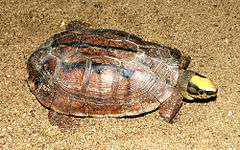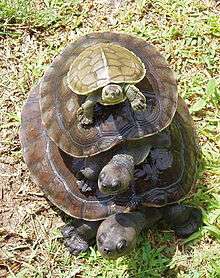Golden coin turtle
| Golden coin turtle | |
|---|---|
 | |
| Scientific classification | |
| Kingdom: | Animalia |
| Phylum: | Chordata |
| Class: | Sauropsida |
| Order: | Testudines |
| Suborder: | Cryptodira |
| Superfamily: | Testudinoidea |
| Family: | Geoemydidae |
| Subfamily: | Geoemydinae |
| Genus: | Cuora |
| Species: | C. trifasciata |
| Binomial name | |
| Cuora trifasciata (Bell, 1825) | |
| Synonyms[1] | |
| |
The golden coin turtle (Cuora trifasciata) or Chinese three-striped box turtle is a species of turtle endemic to southern China and northern Vietnam.[1]
The species is distributed in China (Guangdong, Guangxi, Fujian, Hainan provinces as well as Hong Kong and Macau) and northern Vietnam.[1] The populations from other parts of Vietnam and Laos are now regarded a separate species, the Vietnamese three-striped box turtle (C. cyclornata).[2]
It hybridizes vigorously with its relatives in captivity and in the wild, and hybrids may be fertile. Several of these have been described as new species, such as the Fujian pond turtle ("Mauremys" × iversoni), a hybrid between (usually) males of this species and females of the Asian yellow pond turtle (Mauremys mutica). In addition, the golden coin turtle is suspected to be a parent of the supposed species Chinese false-eyed turtle and Philippen's striped turtle.[3]
The species is considered critically endangered with extinction by the IUCN.[4] It is used in folk medicine,[5] e.g. as the key ingredient for the Chinese medicinal dessert guīlínggāo (龜苓膏); thus it is under threat because of unsustainable hunting. This is one of the most endangered turtle species in the world, according to a 2003 assessment by the IUCN. C. trifasciata is listed among Turtle Conservation Coalition's 25 Most Endangered Tortoises and Freshwater Turtles.[6]
Farming
C. trifasciata is raised on some of China's turtle farms. Based on the data from a large sample (almost one half of all registered turtle farms in the country), researchers estimated that the turtle farmers participating in the survey had the total herd of 115,900 turtles of this species; they sold 20,600 turtles of this species per year, with the estimated value of almost US $37 million. This would make a farm-raised C. trifasciata worth almost $1,800, making them by far the most expensive species tabulated in the survey. (By comparison, a common Pelodiscus sinensis raised for food would be worth under $7, and a Cuora mouhotii, sold for the pet trade, around $80.) Taking into account the registered farms that did not respond to the survey, as well as the unregistered producers, the total amounts must be significantly higher.[7] Wild C. trifasciata are far more valuable than farmed-raised turtles of this species to both TCM practitioners and illegal wildlife traders.[8][9][10] The gender of C. trifasciata is determined gestation temperatures.[6][10] Due to incubation temperatures at farms in warm lowlands, farms have only been able to produce females.[6][10] This increased the price of wild-caught males to $20,000.[6][10] The majority of farmed C. trifasciata are hybrids which can escape and establish populations, causing genetic pollution.[9][10][11][12]
The largest C. trifasciata farming operation is said to be located in Boluo County, Guangdong. According to the farm's founder Li Yi (李艺), the farm was started in 1989 with eight wild turtles (two males and six females) bought at a local market, and now has "over 2000" turtles.[13] According to the farm's site, captive-born turtles start breeding at 8 years of age.[14]
Footnotes
- 1 2 3 Fritz Uwe; Peter Havaš (2007). "Checklist of Chelonians of the World". Vertebrate Zoology. 57 (2): 218–219. Archived from the original (PDF) on 2010-12-17. Retrieved 29 May 2012.
- ↑ Blanck et al. (2006)
- ↑ Parham et al. (2001), Buskirk et al. (2005)
- ↑ ATTWG (2000)
- ↑ da Nóbrega Alves et al. (2008)
- 1 2 3 4 "Turtles in Trouble: The World's 25+ Most Endangered Tortoises and Freshwater Turtles" (PDF). International Union for Conservation of Nature. February 2011.
- ↑ Shi, Haitao; Parham, James F; Fan, Zhiyong; Hong, Meiling; Yin, Feng (2008-01-01), "Evidence for the massive scale of turtle farming in China", Oryx, Cambridge University Press, 42, pp. 147–150, doi:10.1017/S0030605308000562, retrieved 2009-12-26
- ↑ Courtney, Cavaliere (2010). "How TCM Purchases in Western Markets Can Impact Bear Farming Practices in Asia". HerbalGram. American Botanical Council. Retrieved 2 February 2016.
- 1 2 "Conclusions from the Workshop on Trade in Tortoises and Freshwater Turtles in Asia". ASIAN TURTLE TRADE WORKING GROUP. 1 December 1999.
- 1 2 3 4 5 Platt, John R. (20 March 2013). "5 Turtles from Nearly Extinct Species Fly Home to Hong Kong". Scientific American Blog Network. Retrieved 2016-02-01.
- ↑ Norris, Scott (27 March 2007). "China's Turtle Farms Threaten Rare Species, Experts Say". National Geographic News.
- ↑ James, Parham; SHI, HAITAO (2001). "The Discovery of Mauremys iversoni-like Turtles at a Turtle Farm in Hainan Province, China: The Counterfeit Golden Coin". Asiatic Herpetological Research.
- ↑ 财富人物:金钱龟"中国第一人" ("People and fortune: Country's No. 1 Golden-coin-turtle man") 2007-09-24 (Chinese)
- ↑ Liyi Gold-coin Turtle Breeding Farm: Breeding and reproduction
References
- Asian Turtle Trade Working Group (2000). "Cuora trifasciata". IUCN Red List of Threatened Species. Version 2006. International Union for Conservation of Nature. Retrieved 11 May 2006. Listed as Critically Endangered (CR A1d+2d)
- Blanck, T., W.P. Mccord & M. Le (2006): On the Variability of Cuora trifasciata. Edition Chimaira. 153pp.
- Buskirk, James R.; Parham, James F. & Feldman, Chris R. (2005): On the hybridisation between two distantly related Asian turtles (Testudines: Sacalia × Mauremys). Salamandra 41: 21-26. PDF fulltext
- da Nóbrega Alves, Rômulo Romeu; da Silva Vieira; Washington Luiz & Gomes Santana, Gindomar (2008): Reptiles used in traditional folk medicine: conservation implications. Biodiversity and Conservation 17(8): 2037–2049. doi:10.1007/s10531-007-9305-0 (HTML abstract, PDF first page)
- Parham, James Ford; Simison, W. Brian; Kozak, Kenneth H.; Feldman, Chris R. & Shi, Haitao (2001): New Chinese turtles: endangered or invalid? A reassessment of two species using mitochondrial DNA, allozyme electrophoresis and known-locality specimens. Animal Conservation 4(4): 357–367. PDF fulltext Erratum: Animal Conservation 5(1): 86 HTML abstract
External links
- Hong Kong Reptile & Amphibian Society
- Cuora trifasciata
- Information of species
- Asian Turtle Network: Cuora trifasciata
- Species 2000
- Wetlands Biodiversity of Cambodia Retrieved 2007-05-04


